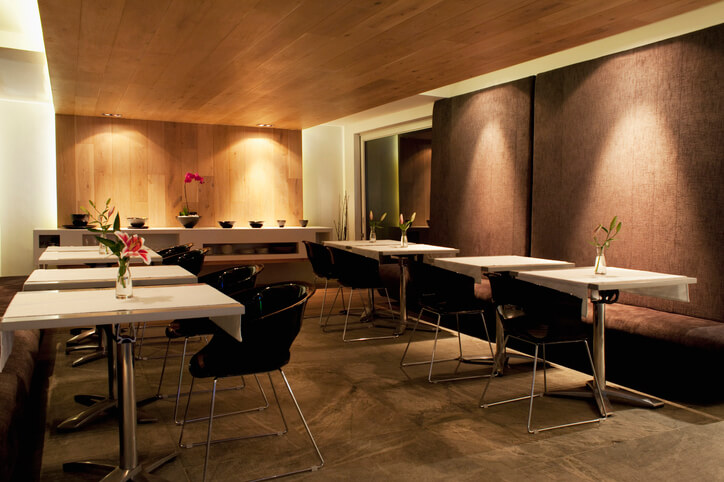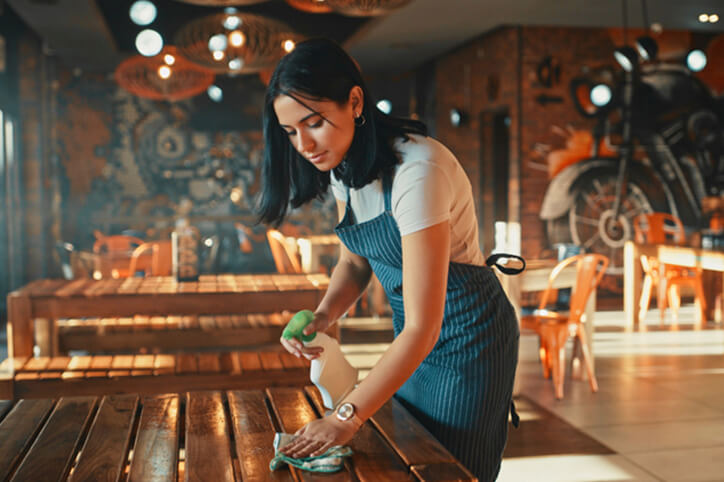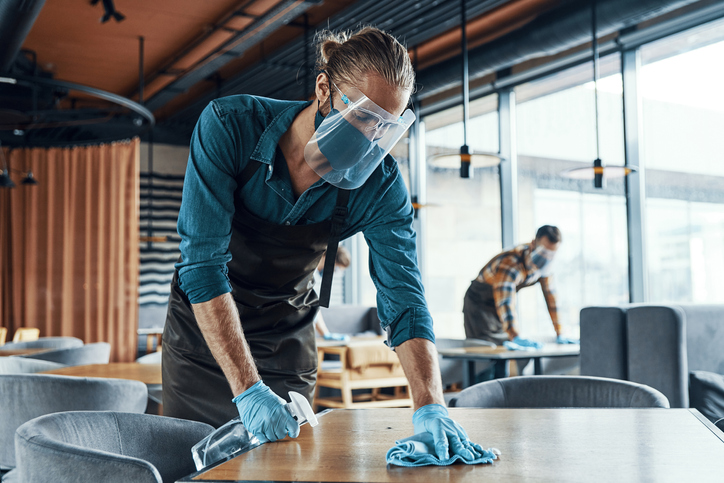Maintaining a clean and well-sanitized restaurant is not just an essential task; it’s a fundamental responsibility for any business in the foodservice industry. A spotless environment protects the health of your staff and customers, ensures compliance with health regulations, and safeguards your restaurant’s reputation. A dirty kitchen or dining area can harbor bacteria and pathogens, potentially leading to foodborne illnesses, operational disruptions, and even permanent reputational damage.
Whether you’re managing a high-end restaurant, a bustling café, or a casual diner, cleanliness impacts every aspect of your business. Beyond routine tidying, deep cleaning ensures all equipment, surfaces, and hidden spaces remain safe and functional. From learning how much to clean a restaurant to mastering techniques like how to clean restaurant equipment, floors, hoods, and floor drains, this guide provides everything you need to maintain impeccable standards. Regency Cleaning Services offers professional solutions for those seeking expert assistance with restaurant cleaning.
The Importance of Restaurant Cleaning
Cleanliness in a restaurant is not merely a legal or regulatory requirement; it’s an operational cornerstone. Here’s why it matters:
- Health and Safety Compliance: Dirty surfaces, improperly cleaned equipment, and unsanitary conditions can lead to food contamination and the spread of illnesses. Restaurants must adhere to stringent health regulations, ensuring safe food preparation and handling practices. Regular cleaning helps prevent foodborne illnesses caused by bacteria like Salmonella, E. coli, or Listeria.
- Enhanced Customer Experience: A clean dining space leaves a lasting impression on customers. Whether it’s sparkling floors or odor-free restrooms, customers associate cleanliness with quality. On the other hand, dirty or unkempt spaces can lead to negative reviews, customer complaints, and declining foot traffic.
- Fire Hazard Mitigation: Grease buildup in hoods, vents, and other kitchen spaces increases fire risk. Regular cleaning minimizes these hazards, ensuring the safety of your staff and property.
- Operational Efficiency: Clean equipment performs better and lasts longer. When appliances, floors, and drains are cleaned regularly, they require less frequent repairs and replacements, reducing downtime and operational costs.
With these benefits in mind, let’s examine how to tackle various aspects of restaurant cleaning effectively.

Restaurant Cleaning Frequency
To determine how much to clean a restaurant, consider the size of your establishment, its volume of business, and the type of food being prepared. A general cleaning schedule includes:
- Daily Cleaning: This includes tasks like wiping down surfaces, sweeping and mopping floors, and cleaning restrooms. These tasks ensure the dining and kitchen areas are clean and ready for the next day.
- Weekly Cleaning: Deep-clean tasks, such as scrubbing walls, cleaning refrigerators, and sanitizing drains, fall under this category.
- Monthly Cleaning: These include detailed tasks such as cleaning the restaurant hoods and vents, deep cleaning the floor grout, and addressing hard-to-reach areas.
Professional services like Regency Cleaning Services can help develop a cleaning schedule tailored to your restaurant’s needs, ensuring every corner is spotless.
Cleaning Restaurant Equipment
Commercial restaurant equipment is exposed to heavy usage, making regular cleaning essential. Dirty equipment not only affects food quality but can also lead to equipment failure. Stainless steel is commonly used in commercial kitchens due to its durability and ease of cleaning, but even stainless steel requires proper care. Knowing how to clean restaurant equipment is a key skill for maintaining a safe and efficient kitchen.
Cleaning procedure for kitchen equipment:
- Preparation: Begin by unplugging and disassembling all equipment, if possible. This ensures you can clean every component thoroughly and safely.
- Cleaning Stainless Steel Surfaces: Use a soft cloth and a mild detergent mixed with water to wipe down surfaces. For stubborn stains, mix baking soda with water to form a paste and scrub gently. Always clean along the grain of the steel to prevent scratches.
- Addressing Grease and Grime: Use a degreaser to break down baked-on grease. For heavily used appliances like ovens and grills, apply a commercial-grade cleaning solution designed specifically for the appliance.
- Sanitizing: After cleaning, rinse all surfaces with clean water and sanitize using a food-safe solution. This step ensures any residual bacteria or cleaning chemicals are removed.
Regular maintenance and cleaning of appliances, such as fryers, refrigerators, ovens, and grills, ensure your kitchen remains functional and safe.
Maintaining Restaurant Floors
Restaurant floors endure constant foot traffic, spills, and grease buildup. Proper cleaning prevents slips, maintains hygiene, and enhances the overall appearance of your space. Whether you’re cleaning tile, wood, or carpeted flooring, consistency is key. Knowing how to clean restaurant floors effectively is essential for maintaining a safe and welcoming environment.
Daily Cleaning Practices
Start by sweeping or vacuuming the floors to remove debris and crumbs. Follow up with mopping, using warm water mixed with a cleaning solution appropriate for your floor type. In high-grease areas, such as near fryers, use an industrial-strength degreaser to break down stubborn residues.
For safety, ensure floors are thoroughly dried to prevent slips. Staff should be trained to address spills immediately to minimize hazards.
Deep Cleaning of Floors
Over time, dirt and grease can build up in grout lines or beneath heavy appliances. Periodic deep cleaning is necessary to remove this buildup. Using a floor-scrubbing machine or steam cleaner can effectively sanitize floors and restore their original shine.
How to Clean Restaurant Hoods?
Kitchen hoods are critical for proper ventilation, filtering smoke, grease, and odors from the cooking area. However, grease and grime can accumulate quickly, compromising air quality and increasing fire risks.
Steps to clean restaurant hoods
- Disassemble Filters: Remove the filters and soak them in warm water mixed with a degreasing solution. This breaks down built-up grease for easier cleaning.
- Scrub the Hood: Use a cleaning solution designed for hoods, and apply it to the interior and exterior surfaces. Use a sponge or brush to scrub thoroughly, eliminating grease and debris.
- Rinse and Dry: Rinse all components with clean water and dry them completely to prevent corrosion.
- Reassemble and Inspect: Reinstall the filters and inspect the hood for any remaining grease or damage.
Professional hood cleaning is recommended every three months, or more frequently if your restaurant uses fryers or grills extensively. Regency Cleaning Services provides thorough hood cleaning to keep your kitchen safe and compliant.
Cleaning and Maintaining Floor Drains
Floor drains are often overlooked but play a crucial role in keeping a kitchen hygienic. Left uncleaned, they can emit foul odors, harbor bacteria, and become clogged, leading to potential flooding.
How to clean restaurant floor drains:
- Flush with Boiling Water: Pour boiling water down the drain to loosen debris and grease.
- Apply a Cleaning Solution: Use a commercial drain cleaner or a natural solution made from vinegar and baking soda to eliminate buildup and odors.
- Scrub Drain Covers: Remove and scrub the drain covers to remove grime and residue.
- Rinse and Sanitize: Rinse the drain thoroughly with water, and sanitize with a bleach solution to kill bacteria.
To prevent clogs, use sink strainers and schedule regular professional drain cleaning.
Why Hire Regency Cleaning Services?
Thorough and consistent restaurant cleaning can be a challenging task. Regency Cleaning Services offers professional, reliable solutions to help your restaurant maintain the highest standards of cleanliness.

Benefits of Choosing Regency Cleaning Services
- Expertise: Our team is trained in industry-best practices, ensuring every corner of your restaurant is spotless.
- Efficiency: We use advanced cleaning tools and techniques to save you time and deliver outstanding results.
- Regulatory Compliance: We ensure your restaurant meets health and safety standards, reducing the risk of fines or closures.
- Customizable Plans: Whether you need a one-time deep clean or ongoing maintenance, we tailor our services to your needs.
Investing in a Clean Restaurant
A clean restaurant is an investment in your business’s success. It protects your customers and staff, ensures compliance with regulations, and creates an inviting atmosphere that keeps customers coming back. From deep-cleaning equipment to maintaining pristine floors and drains, every detail matters. Wondering how much it costs to clean a restaurant? Costs can vary based on the size of your establishment, the scope of cleaning required, and the frequency of service, but professional cleaning is always a worthwhile investment in your reputation and safety.
Don’t let cleaning challenges overwhelm you. Contact Regency Cleaning Services today for professional cleaning solutions tailored to your needs. Let us help you maintain a safe, spotless, and successful restaurant!


